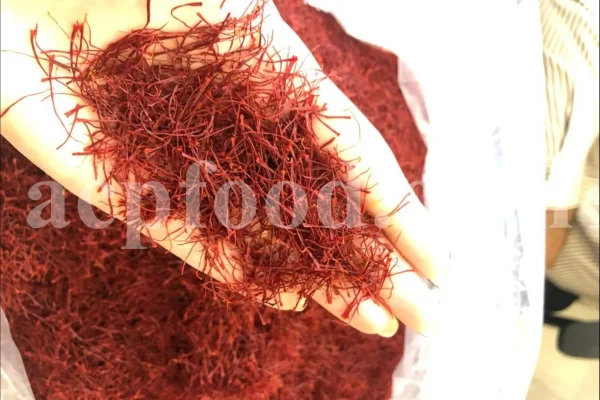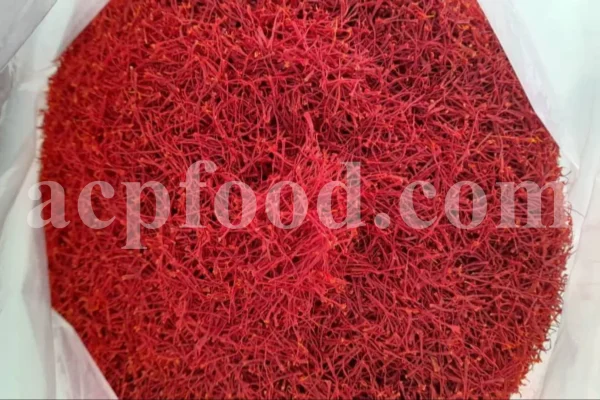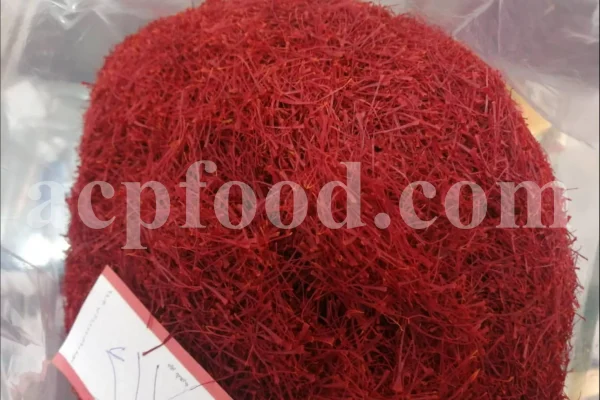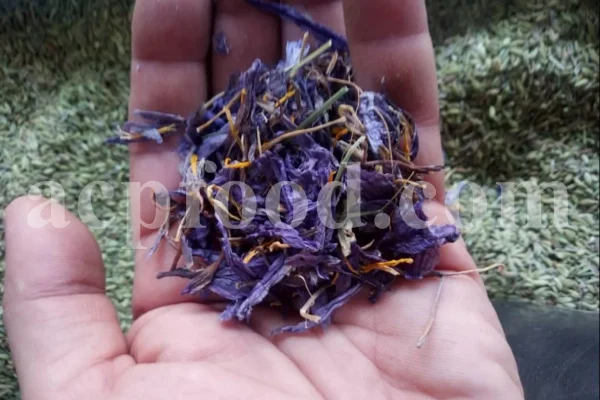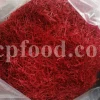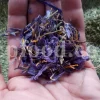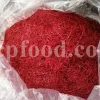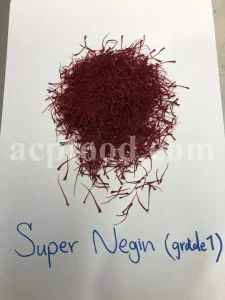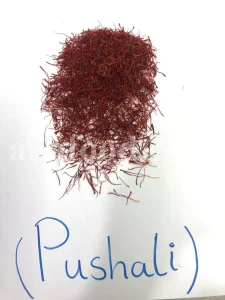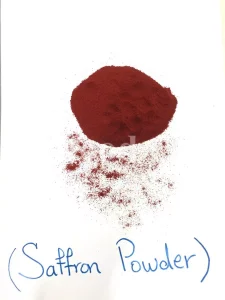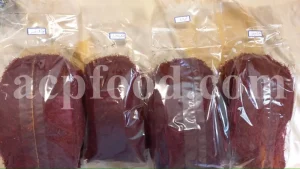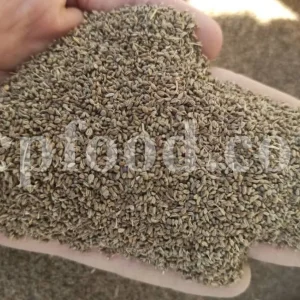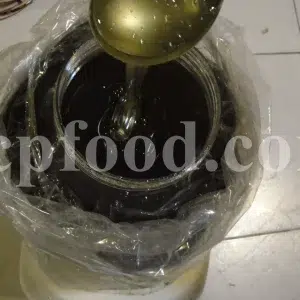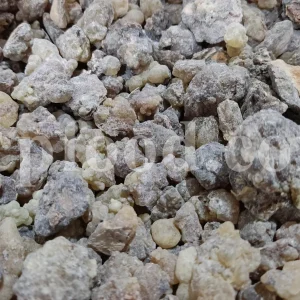GENERAL DATA
Plant parts: Stigma, Flower
Cultivation mode: Cultivated
In manufacturing: Pharmaceutical, cosmetics, confectionary, extract, dairy, beverages, alcoholic drink, meat, sausages, oils, margarine, seasoning, spices, desserts, puddings, skincare, haircare, essential oil.
In food: Along with rice, in stews, herbal tea.
🌸 Industries That Use Saffron Stigma (Crocus sativus L.)
Saffron is the dried stigma of the Crocus sativus flower, renowned as the world’s most valuable spice by weight. It is hand-harvested from autumn-blooming flowers and prized for its aroma, deep color, medicinal benefits, and rich cultural heritage. Iran is the global leader in saffron production and export.
🌿 What Is Saffron Stigma?
The stigma is the thin, thread-like red part of the Crocus sativus flower. It contains powerful bioactive compounds such as crocin (color), picrocrocin (taste), and safranal (aroma), making saffron a unique culinary, pharmaceutical, and cosmetic ingredient.
✅ Non-toxic, safe in culinary doses, and widely used in wellness products
✅ Highly concentrated—just a few threads impact color, taste, and function
1. Food & Beverage Industry
Saffron is a luxury spice used for its vivid golden color, earthy floral aroma, and subtle bitterness.
Applications:
-
Flavored rice, stews, and soups (e.g., paella, biryani, Persian tahchin)
-
Bakery and confectionery: saffron cakes, buns, halwa, ice cream
-
Herbal teas and infusions
-
Saffron syrups, liqueurs, and premium beverages
✅ Used in both gourmet and traditional cuisines worldwide
✅ Natural alternative to synthetic yellow coloring agents (e.g., tartrazine)
2. Nutraceutical & Wellness Industry
Saffron stigma is rich in antioxidants and recognized for mood-enhancing, neuroprotective, and anti-inflammatory effects.
Nutraceutical Uses:
-
Mood and anxiety support capsules (natural antidepressant effect)
-
Vision and macular health blends (especially crocin-based)
-
PMS and menopausal symptom relief
-
Memory and focus supplements (used in nootropic blends)
✅ Backed by clinical studies for mood, sleep, and cognitive support
✅ Used in softgels, teas, capsules, and tonics
3. Pharmaceutical & Medical Nutrition
Used in traditional and modern pharmacopeias for digestive, neural, reproductive, and cardiac health.
Applications:
-
Anti-anxiety and antidepressant formulas (natural SSRI-like effects)
-
Antioxidant and anti-inflammatory drugs
-
Adjunct therapy in Alzheimer’s, Parkinson’s, and macular degeneration
-
Herbal syrups for menstrual regulation or heart health
✅ Studied for safranal and crocin‘s neurochemical roles
✅ Safe in small daily doses; toxic only in large amounts
4. Cosmetic & Personal Care Industry
Saffron is used in premium skincare and haircare formulations for its brightening, anti-aging, and antioxidant properties.
Applications:
-
Skin serums and creams for glow and pigmentation control
-
Traditional facial masks (e.g., Ubtan, saffron-turmeric paste)
-
Hair masks to stimulate shine and growth
-
Bath infusions and spa products for luxury appeal
✅ Often included in Ayurvedic, Persian, and Korean beauty rituals
✅ Marketed as a luxury botanical active
5. Fragrance & Natural Perfumery
Saffron’s volatile compound safranal gives it a warm, leathery, and slightly spicy aroma used in perfumery.
Applications:
-
High-end niche perfumes (especially in the oriental/amber family)
-
Oud-based blends and incense products
-
Aroma diffusers and spiritual oil blends
✅ Used as both a heart note and accent in designer perfumes
✅ Rare and valued in perfumery due to difficulty of extraction
6. Cultural & Religious Use
Saffron is an important part of religious rituals, weddings, and seasonal celebrations in many cultures.
Uses:
-
Added to offerings or holy water
-
Used to dye garments, threads, or ceremonial textiles
-
Symbol of purity and prosperity in many traditions
✅ Integral in Hindu, Zoroastrian, and Buddhist ceremonies
✅ Featured in royal and medicinal traditions throughout history
7. Academic & Clinical Research
Saffron is extensively studied for its unique compounds and therapeutic potential.
Research Focus Areas:
-
Neuropharmacology: antidepressant and nootropic effects
-
Ophthalmology: crocin’s impact on vision health
-
Cancer research: crocin’s effect on apoptosis and tumor growth
-
Nutrigenomics: role in inflammatory gene expression modulation
✅ Saffron stigma is considered a model botanical for standardized extracts
✅ High-profile in ethnopharmacology and integrative medicine
✅ Summary of Key Applications
| Industry | Common Uses |
|---|---|
| Food & Beverage | Spice, colorant, aromatic enhancer in dishes, desserts, drinks |
| Nutraceutical & Wellness | Mood supplements, nootropics, hormonal support |
| Pharmaceutical | Anti-anxiety, vision support, cognitive health, circulatory aid |
| Cosmetic & Personal Care | Skin-brightening creams, anti-aging serums, herbal masks |
| Fragrance & Perfumery | Oriental perfumes, incense, aromatherapy blends |
| Cultural & Religious Use | Ceremonial dyes, religious offerings, traditional rituals |
| Academic & Research | Antioxidant, antidepressant, anticancer, neuroprotective studies |
🌟 Key Features
-
Contains crocin, picrocrocin, and safranal—each with unique therapeutic and sensory effects
-
Used as natural colorant, antidepressant, antioxidant, and skin brightener
-
High value, labor-intensive crop with centuries of traditional use
-
Safe in small doses; contraindicated in very high amounts during pregnancy
-
Grown predominantly in Iran, with high export value and strong global demand
🌸 Industries That Use Crocus sativus Petals (Saffron Flower)
While the stigma of Crocus sativus is globally celebrated as saffron spice, the petals of the flower are increasingly gaining attention for their antioxidant, colorant, and wellness properties. These petals—typically discarded during saffron harvesting—are now being valorized across multiple industries due to their rich bioactive profile and sustainability potential.
🌿 What Are Crocus sativus Petals?
Saffron petals are the purple-violet floral parts of the Crocus sativus flower. Though not aromatic like the stigma, they are rich in polyphenols, flavonoids (e.g. kaempferol), anthocyanins, and carotenoids.
They are non-toxic, gently astringent, and hold mild therapeutic and coloring potential.
✅ Abundant byproduct of saffron harvesting
✅ Rich in antioxidant and anti-inflammatory compounds
✅ Emerging interest in zero-waste and upcycled ingredient categories
1. Nutraceutical & Herbal Supplement Industry
Saffron petals are used in herbal infusions, antioxidant teas, and functional formulations targeting mood, immune balance, and digestion.
Applications:
-
Herbal tea blends for relaxation, digestion, or PMS relief
-
Capsules or powders in antioxidant or anti-stress supplements
-
Mild sedative and anti-inflammatory tonics
✅ Studied for neuroprotective and anti-depressant effects
✅ Gentle alternative to stigma-based formulations (lower cost, less intense)
2. Cosmetic & Personal Care Industry
Saffron petals contain anthocyanins and flavonoids, which have anti-aging, calming, and skin-tone enhancing properties.
Applications:
-
Face masks, scrubs, and petal-infused toners
-
Antioxidant-rich creams for dull or tired skin
-
Petal extract in soothing bath products or foot soaks
-
Natural colorants in lip balms or makeup
✅ Suitable for natural, vegan, and ayurvedic cosmetics
✅ Gentle on skin; low likelihood of irritation
3. Food & Beverage Industry (Colorant & Tea)
Saffron petals are used as natural food colorants and mild herbal teas. Though not flavorful like the stigma, they offer a mild earthy-bitter note.
Applications:
-
Natural coloring agent in syrups, vinegars, or candies
-
Dried petals in herbal tisanes or mixed tea blends
-
Used in traditional beverages and infusions for stress relief
✅ Rich in anthocyanins for violet or purplish hues
✅ Cost-effective compared to other floral colorants
4. Pharmaceutical & Medical Applications
Emerging studies show petals may offer neuroprotective, antihypertensive, and anti-inflammatory activity, making them relevant in herbal pharmaceutics.
Medical Uses:
-
Herbal preparations for depression and anxiety
-
Used in formulations for blood pressure modulation
-
Studied as adjunct therapy in cardiovascular support
✅ Investigated for bioflavonoid content and safety in human studies
✅ Shows synergy with stigma in mood and cognitive health applications
5. Fragrance & Wellness Industry (Aromatics & Spa)
Though not aromatic on their own, the petals are used in botanical blends for spa, bath, and ritual use, valued for their gentle symbolic and soothing presence.
Applications:
-
Botanical bath soaks and floral steam therapy
-
Dried petals in potpourri, sachets, or bath confetti
-
Included in spa facials or Ayurvedic rituals
✅ Visually attractive and psychologically soothing
✅ Eco-luxury appeal in wellness spas and herbal therapy markets
6. Agricultural & Sustainability Applications
As saffron cultivation expands, using petals helps reduce agricultural waste. Petals are explored for:
-
Composting and soil conditioners
-
Extraction of plant-based dyes or food-safe anthocyanins
-
Use in animal feed additives (natural antioxidant source)
✅ Fits into circular economy and upcycling models
✅ Encouraged in eco-farming and regenerative agriculture
✅ Summary of Key Applications
| Industry | Common Uses |
|---|---|
| Nutraceutical & Herbal | Antioxidant teas, mood supplements, relaxation blends |
| Cosmetic & Personal Care | Face creams, toners, scrubs, bath soaks |
| Food & Beverage | Natural colorant, herbal infusions, culinary decoration |
| Pharmaceutical | Herbal sedatives, cardiovascular and anti-inflammatory support |
| Fragrance & Spa | Petal baths, potpourri, spa rituals |
| Agriculture & Sustainability | Upcycled waste, dye extraction, soil enrichment |
🌟 Key Features
-
Rich in flavonoids, anthocyanins, and kaempferol
-
Supports mood, skin brightness, and circulatory health
-
Gently astringent; safe for internal and external use
-
Natural coloring potential for food and skincare
-
Helps reduce saffron farming waste—ideal for eco-conscious brands
🌸 Comparison: Saffron Stigma vs. Saffron Petals
| Feature / Attribute | Saffron Stigma 🌺 (Crocus sativus stigma) | Saffron Petals 🌸 (Crocus sativus petals) |
|---|---|---|
| Plant Part | Red stigma (female reproductive structure) | Purple flower petals |
| Harvest Method | Hand-picked, labor-intensive | Byproduct of stigma harvest |
| Color | Deep red to reddish-orange | Violet to lavender-purple |
| Primary Compounds | Crocin (color), Safranal (aroma), Picrocrocin (flavor) | Kaempferol, anthocyanins, flavonoids |
| Flavor / Aroma | Warm, earthy, mildly bitter, aromatic | Mild, slightly bitter or grassy |
| Therapeutic Properties | Antidepressant, antioxidant, neuroprotective | Antioxidant, anti-inflammatory, calming |
| Food Industry Use | Premium spice, colorant, aroma enhancer | Natural colorant, herbal infusions |
| Pharmaceutical Use | Cognitive health, PMS relief, macular health | Antihypertensive, mood support (milder) |
| Nutraceutical Use | Mood, vision, memory, women’s health | Antioxidant teas, relaxation, circulatory aid |
| Cosmetic Use | Brightening serums, anti-aging skincare | Floral water, toners, bath and spa cosmetics |
| Fragrance Use | Used in high-end perfumes (safranal aroma) | No strong scent; used for visual/spa purposes |
| Market Value | Extremely high (world’s most expensive spice) | Very low (usually discarded or upcycled) |
| Regulatory Status | Widely approved food additive and supplement | Less regulated; emerging functional ingredient |
| Toxicity | Safe in low doses; toxic in excess (5g+) | Generally recognized as safe |
| Yield Ratio | ~150,000 flowers = 1 kg stigma | 150,000 flowers = ~10–15 kg petals |
| Availability | Limited, global demand | Readily available byproduct |
🧪 Summary Table: At a Glance
| Category | Stigma 🌺 | Petals 🌸 |
|---|---|---|
| Potency | Very high (bioactive concentration) | Moderate (supportive compounds) |
| Price Range | Extremely expensive | Low cost or often discarded |
| Coloring Power | Strong golden-yellow | Violet to pinkish-purple |
| Taste & Aroma | Distinct, prized flavor & aroma | Subtle, faint bitterness |
| Main Use Case | Spice, nutraceutical, perfumery | Tea, cosmetic, coloring, sustainability |
| Sustainability | High waste in stigma-only use | Excellent for upcycling |
🌟 Key Insight
While saffron stigma is a luxury functional ingredient with high potency and global recognition, saffron petals offer a sustainable, lower-cost alternative for cosmetic, herbal, and colorant applications, especially in wellness and eco-conscious markets.
HARVEST CALENDAR
Feb
Mar
Apr
May
Jun
Jul
Aug
Sep
Oct
Nov
Dec
To order Zafran, please contact us.
About Crocus Sativus
Saffron is the stigma of a herbaceous and perennial plant that reaches twenty centimeters in height. Its stem is white, relatively thin, and its cross section is circular. The leaves are elongated, very narrow and pointed and grow directly from its underground bulb. The flowers are relatively large and purple, and each flower has six oval petals and are completely separate.
The style’s stigma of each flower has three elongated, very narrow, red strands. So that for every hundred thousand fresh Saffron flowers, only one kilo of dry Saffron is obtained. The style’s stigma of Saffron flower has a bitter taste and a very pleasant smell. The best Saffron is red, colorful, fresh, has a thick aroma and a very pleasant and bitter taste. The underground bulb of the Saffron plant is almost spherical, conical and very small and has a brown skin. But inside it is white.
Crocus sativus Chemical Constituents
The color of Saffron is due to a diterpene crocin, which is the gentiobiose ester of crocetin—a diterpene acid having a structure resembling carotenoids. The bitter taste of Saffron is attributed to picrocrocin, a glycoside yielding glucose and safranal on hydrolysis. Safranal is dihydro b-cyclocitral and is the main odoriferous constituent. The bulbs contain four isolectins. Tepals yield myricetin, quercetin, kaempferol, delphinidin, petunidin, astragalin and helichrysoside. Pollen is found to contain crosatosides A and B and kaempferol glycoside.
To order Persian Saffron, please contact us.
Saffron Temperament
Hot and dry.
Saffron Health Benefits
1. Eat it. Reduces brain irritations, increases urination and perspiration of the skin, enriches the blood and facilitates and accelerates its flow, is useful for expelling measles rashes. It cures stomach and nerve pains, seizures and coughs and hysteria. Expels humors from the brain and nervous system, strengthens the heart.
2. Eating it mixed with honey cause enlivening and laughter, it is useful for crushing bladder stones.
3. Cooking two grams of it in one liter of water is useful for treating bleeding under the skin and abscess.
4. Brew 15 grams of it in a liter of boiling water and drink 2 to 3 cups of it every day. It is tonic and bracing for the body, stimulates and strengthens the liver and respiratory system, strengthens the senses and brain, has important effects in the treatment of menstrual disorders and opens menstruation, and relieve low back pain that is associated with the menstrual disorders. Is useful for relieving stomach cramps and pain.
5. Pulverize it as much as a pea every day and mix it with Rose Water and drink it. Relieves gallbladder inflammation.
6. Dissolve 2.3 grams of Autumn Crocus in sugar syrup and give it to a woman who wants to give birth to a baby. It makes childbirth easier.
11. Rubbing it on the eyes with Rose Water is useful to increase eyesight, eye conjunctivitis and heal scabies and eye injuries.
12. Its suppository is useful for uterine and anal pain.
13. If you pulverize it softly with nutmeg and use as a suppository in vagina, it is useful for treating women who do not get pregnant for some reason.
14. Mix some of it in spurges milk and poultice it on the aching organ. Relieves pain.
15. Pour healthy, uncrushed and high quality Crocus sativus in a closed glass and smell it several times a day. It is soothing and soporific, eliminates olfactory weakness.
Saffron Side Effects
Smelling the soft powder of Autumn Crocus causes severe headaches, dizziness and tremors, eating it decrease the appetite, causes vomiting, causes colic, is harmful to the kidneys, causes miscarriage in pregnant women, prolonged consumption of which cause gaga. It is harmful to the nerves.
Saffron Modifier
Anise and Sekanjebin.
To order Persian Saffron, please contact us.

